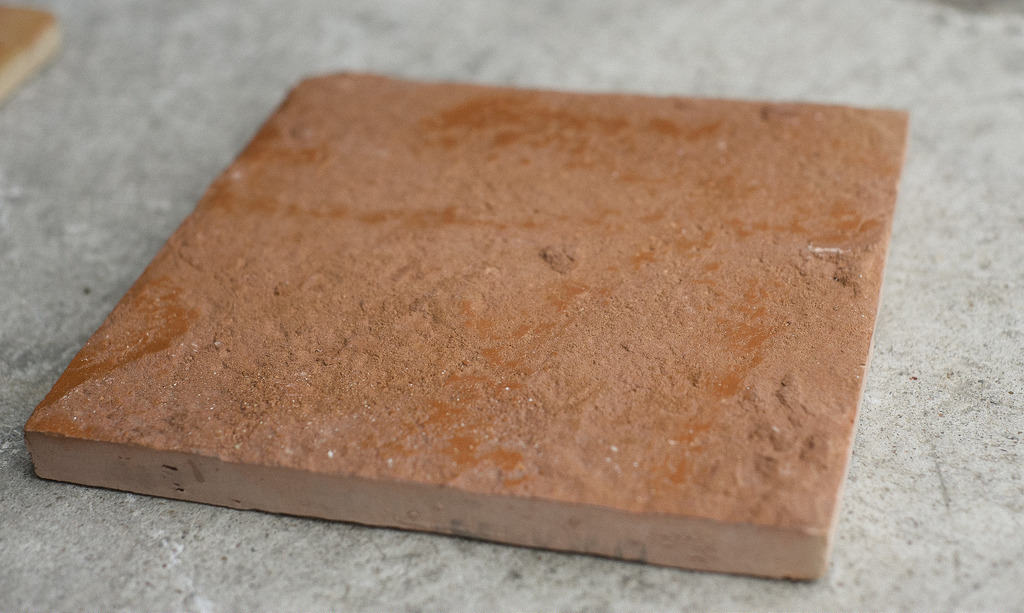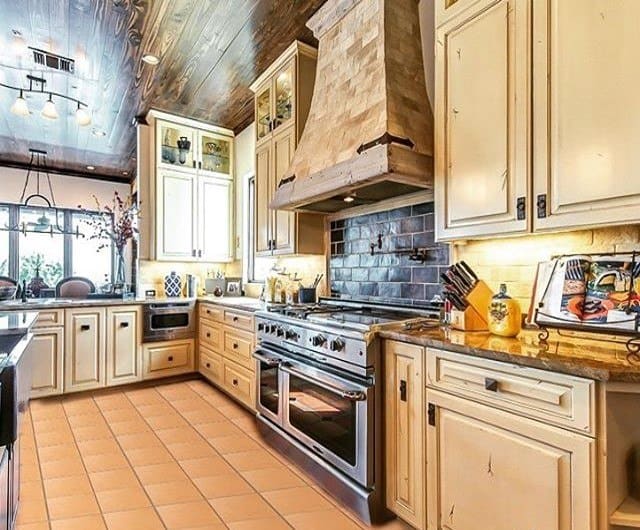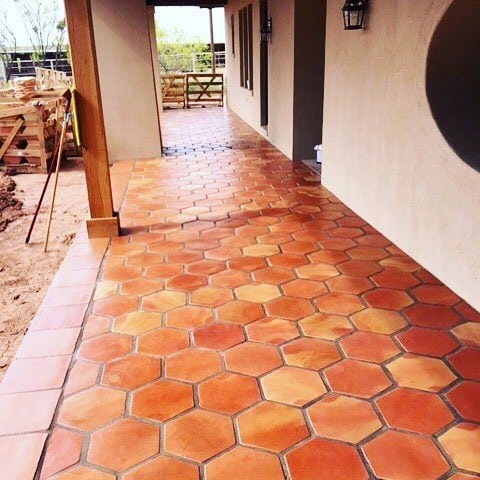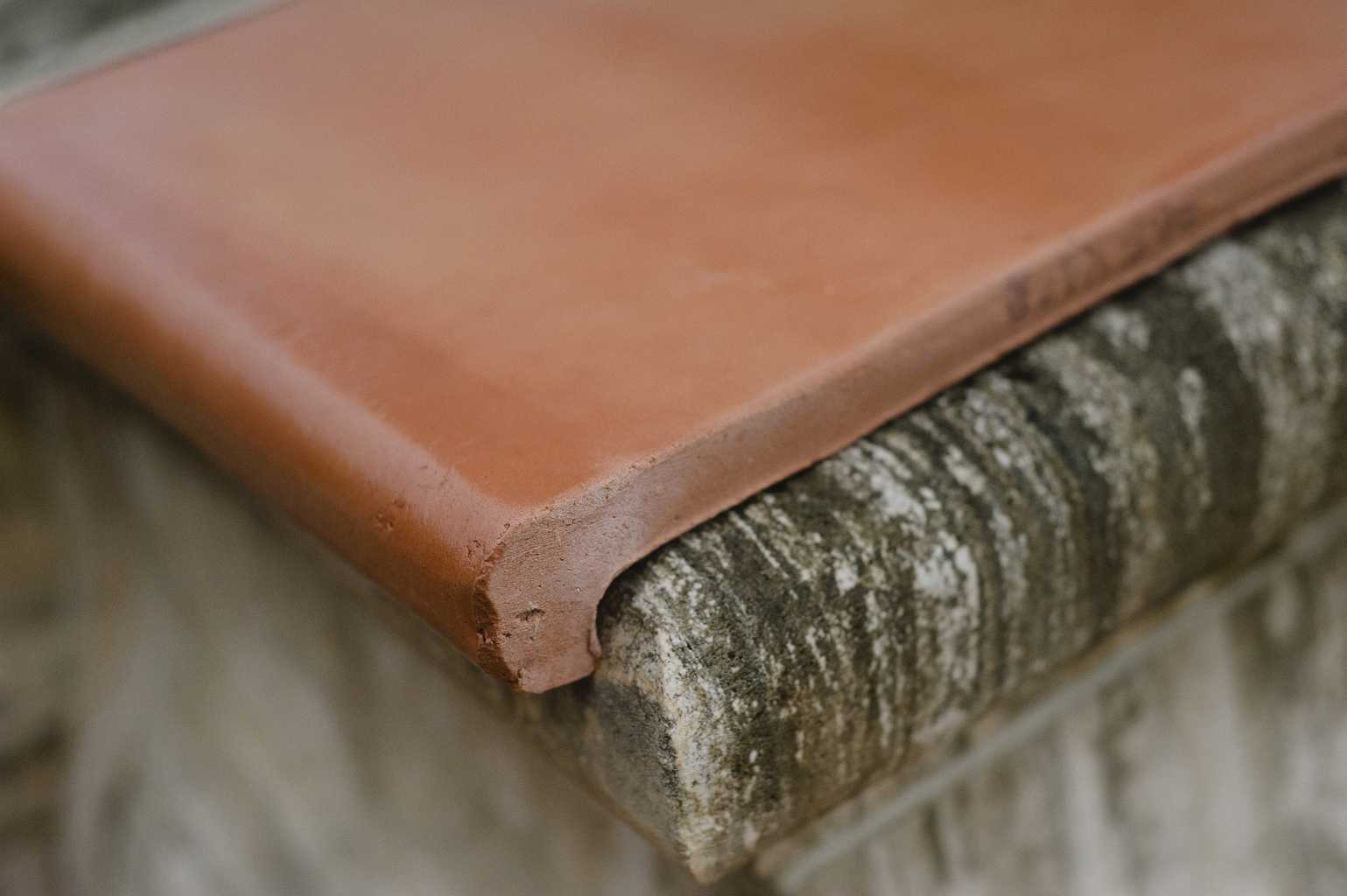Saltillo Mexican tile has been used in homes in Central and South America for hundreds of years. Though not durable enough to withstand harsh winters outside, these tiles are lovely indoors anywhere. The challenges of this type of flooring include installation of Saltillo tile, restoration of Saltillo tile, and maintaining Saltillo tile. But the benefits — rustic beauty, non-toxic materials used to manufacture, and low cost — may outweigh any drawbacks.
Bring the beauty and peace of Mexico to your home with Saltillo floor tiles. When paired with the right décor, Saltillo tile can have a bit of an exotic feel. It also makes for great solar mass for homes using passive solar energy!
Many choose Saltillo tile due to the:
- Natural beauty of the tiles themselves.
- The non-toxic materials used to manufacture the tiles.
- The low-cost of the tiles for the high end look.
Saltillo tile has its challenges, which include:
- The tiles themselves are extremely fragile.
- Maintaining and cleaning the tiles is tedious.

(Photo credit: Rustico Tile and Stone)
What is Saltillo Tile?
Saltillo tile is a type of terra-cotta tile made only in northern Mexico. These tiles are made of natural clay that is first shaped by hand and then dried in the sun. Saltillo tiles are then kiln fired to ensure hardness and durability. The tiles are carefully positioned in the kiln in order to create different colors. Depending on the tile position in the kiln, the resulting tiles can range in hue from pale amber to dark terra-cotta. Traditionally, Saltillo tiles are left unglazed, although some manufacturers sell them pre-treated or pre-sealed in order to increase their durability.
Naturally, Saltillo tile is not terribly strong or hard. Although it is comparable to other natural stone tiles (such as slate or granite) it can chip and crack. When used as exterior tiling, it can only be used in very mild climates, as harsh weather can damage the tile. Really, Saltillo tile should not even be used indoors in places that are particularly cold, as they will not be able to hold up in the face of colder temperatures. Saltillo tile typically has a MOH (measure of hardness rating) between a 3 and 4, which is fairly low (compare to porcelain, which has an average MOH of 7-9). Therefore, it is very rarely used for outdoor purposes these days, though it very warm climates, well maintained and sealed Saltillo tile makes for a nice tile flooring option for a patio. However, the elegance and beauty Saltillo Tile brings to the interior of the home more than makes up for its lack of strength and hardness.

(Photo credit: Rustico Tile and Stone)
Installing Saltillo Tiles
Installing Saltillo tile also has to be done carefully, as the tiles are delicate. Any grout or chemicals spilled on the tiles can damage them, so it is crucial to keep the tiles covered with paper until the installation is complete. This is not typically something that you will want to attempt yourself unless you have a good bit of experience with tile installation and feel confident with your abilities. However, because individual Saltillo tiles are so inexpensive, you can take a little liberty and losing one or two tiles during installation will not obliterate your flooring budget.
Prior to starting installation, you will need to make sure the subfloor is perfectly prepared. The flooring must be perfectly level and there are no cracks, holes or misalignments where moisture can get trapped. The tiles can be laid starting in one corner of the room or starting from the middle of the room, but the last row of tiles will need to be cut carefully to fit. Once the tiles have all been laid, a sealer will need to be applied, then a grout, and finally at least a second layer of the sealer.

Sealing Saltillo Tiles
Saltillo tile was introduced to Mexico by Spaniards hundreds of years ago, and the process of making the tile has remained the same since. The tile is actually named after the Mexican town of Saltillo, which produces the right clay and weather for making this popular tile.
As Saltillo tiles are fired at such low temperatures, they remain very porous and are therefore very susceptible to water damage. It is almost exclusively recommended these days that you seal Saltillo tiles to protect them from water, wear, and scratches. Typically, Saltillo tiles should be sealed after they have been installed and are completely dried and clear of extra dirt and debris. You will want to decide primarily how much shine you are wanting from your floors and choose a level of gloss or matte for the sealant and polish appropriately. Sealant should be applied in several coats, and the number of coats can vary depending on the manufacturer’s recommendation.
Maintaining Saltillo Tiles In the Home
Saltillo tile in the home has a few drawbacks. Regular sweeping is one of the best ways to maintain the Saltillo tiles in your home. While some recommend vacuuming, regular vacuuming could chip the tile, which is why sweeping is really the preferred method for daily maintenance. For a deeper cleaning, unsealed and untreated tile needs to be laboriously cleaned with diluted ammonia and “elbow grease”, and lots of rinsing. Saltillo tile floors need stripping and resealing, before and after cleaning to do a proper job. It is important to also wipe up any spills and dirt right away, as the tiles can stain. If the floor is ever flooded, the delicate tiles will be severely weakened. Only slightly damp mops can be used on the floors, and only the very mildest cleansers (no harsh chemicals). Also, a sealant will have to be reapplied regularly to keep the floor in good condition.

(Photo credit: Rustico Tile and Stone)
If you are planning to refinish Saltillo tiles, you will need to make sure any previous polish or sealant has been completely stripped and all that remains is the basic Saltillo tiles. To strip the tiles, you should use a gentle solvent and a soft bristle brush to prevent damage to the tiles themselves. Also, when refinishing, a new grout will have to be applied along with the new sealant.
Why Choose Saltillo Tile
Despite these disadvantages, there are many benefits to selecting Saltillo tile for your flooring needs. Primarily, Saltillo Mexican tile is beautiful and offers design flexibility. Whether you have a modern home, a country French-style residence, or love the Mediterranean style, the natural beauty of Saltillo tile can make your home truly stand out. Although this tile requires a little more effort to care for, many homeowners and decorators feel that it is well worth it for the beauty it brings to any room. Modern sealants do make cleaning and caring for Saltillo tile easier than ever before. The tile itself is comparatively inexpensive and many homeowners like the all-natural products that go into the tile-making process. At a time when we are surrounded by chemicals, it is nice to bring a natural product into the home.
The greatest benefit to Saltillo tile is that, because it is inexpensive, people feel free to experiment with various patterns and designs with the tiles and the results can be truly unique and spectacular. The tiles are readily available via almost all leading suppliers and, therefore, sourcing the product is not difficult at all. There are even blogs dedicated to various Saltillo designs where you can find inspiration and demonstrations of a whole selection of incredible designs. Perusing these visual examples can give you a clear idea as to how you want your flooring to look. If you need further or more specific advice, your Saltillo tile supplier will be able to recommend a few experts who can help you make your choices.

(Photo credit: Rustico Tile and Stone)
In general, natural tile flooring is a beautiful and durable flooring option for your home. If you’re looking for advice on specific tile flooring options, most popular professional companies, such as Lumber Liquidators, are happy to provide information regarding specific tile flooring options or installation and will even do in-home consultations at no charge. If you want a naturally beautiful and affordable flooring solution, consider installing Saltillo tile in your home. It has been trusted by savvy homeowners for hundreds of years. Is it time for you to trust too?

I have a large portion of saltillo tile thougout my entire home. Although, I too love the natural stone, it always looks dirty. Dark with a burned look and a dirty look. I have scrubbed and scrubbed but it still looks dirty with dark grout. Can I stain the saltillo tile a red color? How do I stip the tiles and make them brighter or a red color?
Hi Sedona,
Look at the comment above yours and follow the link. You’ll find everything you need. Good luck!
I’m looking to install super saltillo tile on my outdoor patio in Los Angeles & the contractor says I should use spec mix (type s) mixed with an acrylic latex additive instead of thinset to install. It’s being laid on a combination of old & new concrete, some of it is slightly uneven & this is why he says it is better to go with mortar mix, so he can ‘float’ the tile where necessary.
I see most people recommending thin-set for this type of job & wonder if it will be ok to use mortar mix/acrylic latex additive instead.
Any insight/advice would be much appreciated.
Thanks in advance,
Mark
Hi Mark,
Should be ok and makes sense considering that the concrete that the saltillo is being laid on is uneven.
I also have a large area in my home of saltillo tile. We have lived in this home for 8 years and the tile has become very dull and is very difficult to clean. Is resealing a job we can do ourselves or should we hire it out? Also, do you strip before you clean or clean, strip, and then reseal? Also, do you have to stain?
I have terracotta tile that has been stained by the white grout (apparently it was pre-sealed before grouting). I stripped the seal, but no cleaners have successfully removed the grout. As an act of desperation, I was planning to apply a dark stain to the tiles in hopes that it will cover the grout stains. Will this work?…where can I find such a stain? I appreciate the help. Thanks, Aaron
Hi Randa,
It probably isn’t necessary to clean before you strip. You can reseal yourself, but if you feel it’s going to be too big of job, then you should consider hiring a professional. You don’t have to stain – people just do that to change the color of the tile. Head over to http://www.aquamix.com to get an idea of what kind of products you’ll be wanting to use – very educational! Not saying you have to use their products, just that it will give you a very good idea of what products you’ll want to use.
Hi Aaron,
Are you sure it’s grout? It could be efflorescence. Either way, head on over to http://www.aquamix.com to get an idea of what kind of products you’ll need. If it is grout it can be removed. If it’s efflorescence, that can be removed too and sealing it helps protect the floor. There aren’t any moisture issues under the floor, right?
We are in Nassau Bay (home of NASA) and we really want to refurb our den saltillo after flooding during hurricane Ike. Is it possible to refinish and stain? It is laid on a mud bed but we have dried well.
Thanks for any suggestions.
Hi Margaret-Mary,
This has been discussed many times in this thread. Go to http://www.aquamix.com and look over the product choices they have for saltillo. This will give you a very good idea of the kinds of products you’ll need to shop for.
Hi
I have several saltillo tiles that are damaged. They almost look like the tops of them have been skined off down to a powdery rough flat finish. Can those tiles be sanded somewhat smooth and then sealed to bring back a shine. If not can a individual tiles be removed and replaced and if so what’s the best way to extract them.
Thanks
Help! I have saltillo on my outdoor patio (10 yrs. old) and it is looking old, tired and needs a lift. I am wondering how to make the grout look new/newer, make it pop and fresh looking? It is very ashy and dull looking -along with the tile. I will reseal once I get the grout to look a bit better!
Hi Ron,
Yes, I would think that the damaged tiles can be sanded some and then sealed/polished. If you wind up needing to replace them, then you’ll probably just have to chisel them out. I would try to not do this, as you’ll have to do some re-grouting and chances are the grouting won’t match. In reality though, it all depends on what you can happily live with. ;~)
Hi Letty,
Is the grout just dirty? If so, I would recommend StainSolver – it’s an oxy type product, but would
be better than OxyClean because it’s got more bleaching action. It should help with the saltillo too, though you may want to try something like Enviro-One. It’s been good for
stain removal in general and would probably even work on the grout too.
Thanks, I’ll get busy trying StainSolver and/or Enviro-One. If that does not give me the look I want I’m tempted to try to restain the grout with additional grout, would you recommend I pain stakingly try to stain/restain with grout a shade or two darker?
I HAD a very lovely, aged saltillo floor in my home here in Kona. We clean and seal(aside from daily cleaning) every 6 mos. Somehow my husband must have mixed the cleaner and sealer and we are stuck (literally) with a sticky, oilyish mess. He used an entire quart of stripper on just a small portion of the floor and after 2 applications/removal of the stripper, we still have lots of gunk left. The condo is only 460sq. ft. and he just worked on 1/5th of the floor. How can we get the gunk off? It was so beautiful and aged and now it has to be stripped to “new” tile look. HELP!!!
Mahalo,
Janet
Hi Letty,
Of course that’d be entirely up to you, but I’m betting you won’t have to. ;~)
Hi Janet,
It could be you’re not letting the stripper stay on the floor long enough to do it’s job. What product are you using? I like Aqua Mix products myself.
After Hurricane Katrina our house had extensive repair work. I kept the saltillo tiles we have had over 20 yrs on our kitchen floor and countertop. I had a professional from Texas do the work and asked that he reseal my kitchen counter tiles.
His work has not held up too well and I have a real dilemma with the countertops. Food, paper, etc sticks to the counter and I have to scrub it with a brush. I worry about food contamination. I have contacted the professional and he suggested purple power to get it off and another sealer. It is not coming off and it badly needs stripping. No one in the New Orleans area really want to fool with it.
The man who did the work said he sealed the counter tile and floor tile with Mexiglaze. What can I use to strip this stuff off.
Hi Lois,
Their website is http://www.aldonchem.com/pr-mexiglaze.htm – they should be able to assist you.